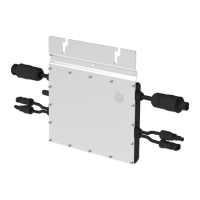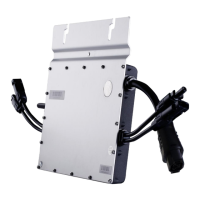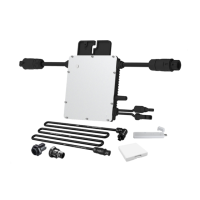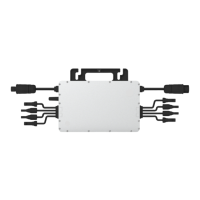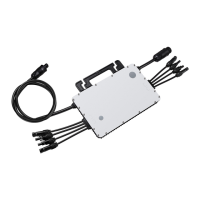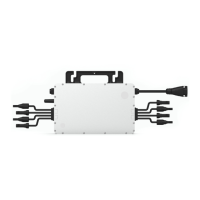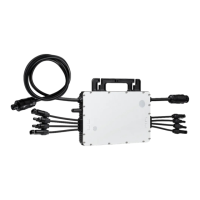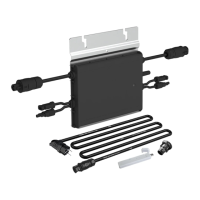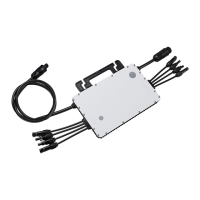Do you have a question about the Hoymiles HM-600 and is the answer not in the manual?
Provides guidance on the manual's content and intended audience for safety.
Notifies users about potential product changes and manual updates.
Lists the available Hoymiles Microinverter models: HM-500, HM-600, HM-700, HM-800.
Explains safety symbols like Danger, Warning, and Caution used in the manual.
Provides critical safety guidelines for installation and operation of the microinverter.
Details the meaning and usage of symbols related to safety and compliance, such as WEEE symbol.
Addresses potential radio interference and provides measures to mitigate it.
Introduces the Hoymiles 2-in-1 unit microinverter technology and its benefits.
Lists key features and specifications of the microinverters, including power output and efficiency.
Identifies and describes the AC and DC connectors on the microinverter unit.
Provides the physical dimensions of the microinverter unit in millimeters.
Explains the different operating modes: Normal, Zero Export Control, and Standby.
Lists optional accessories required for installation, such as AC connectors and cables.
Offers essential precautions for installing the microinverter, emphasizing environmental protection.
Specifies the necessary clearance around the microinverter for proper installation and ventilation.
Details the preparatory steps before installation, including environmental checks and safety measures.
Outlines the procedural steps for installing the microinverter onto the mounting rails.
Describes the process of physically mounting the microinverter onto the solar panel rail system.
Details how to connect the AC output cables between microinverters to form a branch circuit.
Explains the process of preparing and connecting the AC end cable for the circuit.
Guides the user on creating an installation map by affixing serial number labels.
Instructs on mounting PV modules and connecting their DC cables to the microinverter.
Explains the steps to safely energize the microinverter system after installation.
Guides on setting up the monitoring system using the DTU and related documentation.
Provides a comprehensive list of alarm codes, their names, and suggested solutions for common issues.
Describes the meaning of different LED light patterns for diagnosing microinverter status.
Details steps for qualified installers to perform on-site checks for troubleshooting.
Outlines procedures for regular maintenance of the microinverters to ensure optimal performance.
Provides step-by-step instructions on how to safely remove and replace a microinverter.
Outlines the procedure for safely disconnecting and removing the microinverter from the system.
Provides guidelines for proper storage and transportation of the microinverter components.
Gives instructions on how to dispose of the microinverter equipment in an environmentally responsible manner.
Explains the earth fault alarm monitoring and its indication via the LED.
Describes supported power quality response modes like Volt-Watt mode for voltage variation.
Explains Demand Response Modes (DRM) and their control signals.
Details the DC input specifications for various microinverter models, including voltage and current.
Lists the AC output specifications for the microinverters, such as power, voltage, and current.
Presents the efficiency ratings and safety/protection features of the microinverters.
Provides mechanical specifications like operating temperature, dimensions, weight, and enclosure rating.
Summarizes key features including communication, monitoring, warranty, and compliance standards.
A template for mapping the installation of microinverters and PV modules.
Illustrates the wiring diagram for a single-phase 230VAC system setup.
Shows the wiring diagram for a three-phase 230VAC/400VAC system setup.
Provides guidance on the manual's content and intended audience for safety.
Notifies users about potential product changes and manual updates.
Lists the available Hoymiles Microinverter models: HM-500, HM-600, HM-700, HM-800.
Explains safety symbols like Danger, Warning, and Caution used in the manual.
Provides critical safety guidelines for installation and operation of the microinverter.
Details the meaning and usage of symbols related to safety and compliance, such as WEEE symbol.
Addresses potential radio interference and provides measures to mitigate it.
Introduces the Hoymiles 2-in-1 unit microinverter technology and its benefits.
Lists key features and specifications of the microinverters, including power output and efficiency.
Identifies and describes the AC and DC connectors on the microinverter unit.
Provides the physical dimensions of the microinverter unit in millimeters.
Explains the different operating modes: Normal, Zero Export Control, and Standby.
Lists optional accessories required for installation, such as AC connectors and cables.
Offers essential precautions for installing the microinverter, emphasizing environmental protection.
Specifies the necessary clearance around the microinverter for proper installation and ventilation.
Details the preparatory steps before installation, including environmental checks and safety measures.
Outlines the procedural steps for installing the microinverter onto the mounting rails.
Describes the process of physically mounting the microinverter onto the solar panel rail system.
Details how to connect the AC output cables between microinverters to form a branch circuit.
Explains the process of preparing and connecting the AC end cable for the circuit.
Guides the user on creating an installation map by affixing serial number labels.
Instructs on mounting PV modules and connecting their DC cables to the microinverter.
Explains the steps to safely energize the microinverter system after installation.
Guides on setting up the monitoring system using the DTU and related documentation.
Provides a comprehensive list of alarm codes, their names, and suggested solutions for common issues.
Describes the meaning of different LED light patterns for diagnosing microinverter status.
Details steps for qualified installers to perform on-site checks for troubleshooting.
Outlines procedures for regular maintenance of the microinverters to ensure optimal performance.
Provides step-by-step instructions on how to safely remove and replace a microinverter.
Outlines the procedure for safely disconnecting and removing the microinverter from the system.
Provides guidelines for proper storage and transportation of the microinverter components.
Gives instructions on how to dispose of the microinverter equipment in an environmentally responsible manner.
Explains the earth fault alarm monitoring and its indication via the LED.
Describes supported power quality response modes like Volt-Watt mode for voltage variation.
Explains Demand Response Modes (DRM) and their control signals.
Details the DC input specifications for various microinverter models, including voltage and current.
Lists the AC output specifications for the microinverters, such as power, voltage, and current.
Presents the efficiency ratings and safety/protection features of the microinverters.
Provides mechanical specifications like operating temperature, dimensions, weight, and enclosure rating.
Summarizes key features including communication, monitoring, warranty, and compliance standards.
A template for mapping the installation of microinverters and PV modules.
Illustrates the wiring diagram for a single-phase 230VAC system setup.
Shows the wiring diagram for a three-phase 230VAC/400VAC system setup.
| Model | HM-600 |
|---|---|
| Category | Inverter |
| Max Output Power | 600W |
| Input Voltage Range | 16V-60V |
| Startup Voltage | 22V |
| Maximum Input Voltage | 60V |
| Output Voltage | 230V |
| Output Frequency | 50Hz/60Hz |
| Efficiency | 96.5% |
| Nominal Output Current | 2.6A |
| Enclosure Rating | IP67 |
| Number of MPPTs | 2 |
| Cooling Method | Natural Convection |
| Nominal Output Voltage/Range | 230V |
| Ambient Temperature Range | -40°C to +65°C |
| Operating Temperature Range | -40°C to +65°C |
| Protection Features | Over/Under Voltage Protection, Over Temperature Protection |
| Communication | 2.4G RF |
